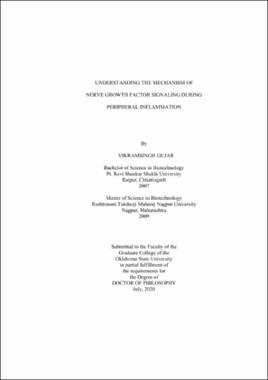| dc.contributor.advisor | Miller, Kenneth E. | |
| dc.contributor.author | Gujar, Vikramsingh | |
| dc.date.accessioned | 2023-04-20T18:24:49Z | |
| dc.date.available | 2023-04-20T18:24:49Z | |
| dc.date.issued | 2020-07 | |
| dc.identifier.uri | https://hdl.handle.net/11244/337448 | |
| dc.description.abstract | Scope and Method of Study: The purpose of this study is to understand the role of nerve growth factor (NGF) signaling in the development and maintenance of peripheral inflammation. Dermal-epidermal separation technique, western blot analysis, confocal microscopy, quantitative image analysis, and qualitative PCR were used to evaluate the phasic expression of NGF in the epidermis of an inflammatory animal model. Pharmacological inhibition and pain behavioral studies were implemented for determining the involvement of NGF in the expression of dorsal root ganglion (DRG) glutaminase during the process of peripheral inflammation and nociception. | |
| dc.description.abstract | Findings and Conclusions: Cold thermolysin epidermal-dermal separation technique was found to be useful for evaluating the alteration in the expression of inflammatory mediators like IL-6 and neurotrophins such as NGF during inflammation in epidermal tissue. As the separation takes place at a cold temperature (4°C), the integrity of protein and mRNA is maintained, allowing us to evaluate the temporal expression pattern. A significant elevation of NGF was observed at two different time points, indicating a biphasic expression in the epidermis of adjuvant-induced arthritic (AIA) animals. This temporal change in the expression of NGF might help in determining time-points for therapeutic intervention by peripheral inhibition of NGF signaling. We also showed that the peripheral inhibition of NGF signaling by either TrkA or Rab7GTPase attenuates the elevated glutaminase levels in DRG cell bodies during inflammation. These results indicated that the NGF signaling is involved in the process of glutamate metabolism for developing and maintaining the peripheral inflammatory process by sensitizing the primary sensory DRG neurons. Also, the peripheral inhibition of Rab7 by a receptor antagonist provided an analgesic effect in animals suffering from hyperalgesia due to AIA. Overall, the results of this study show that NGF plays a vital role in altering the expression of glutaminase in DRG neurons. Furthermore, peripheral blockade of NGF signaling via TrkA or Rab7 along with glutaminase inhibition can lead to the development of an analgesic regime for treating inflammatory pain. | |
| dc.format | application/pdf | |
| dc.language | en_US | |
| dc.rights | Copyright is held by the author who has granted the Oklahoma State University Library the non-exclusive right to share this material in its institutional repository. Contact Digital Library Services at lib-dls@okstate.edu or 405-744-9161 for the permission policy on the use, reproduction or distribution of this material. | |
| dc.title | Understanding the mechanism of nerve growth factor signaling during peripheral inflammation | |
| dc.contributor.committeeMember | Koehler, Gerwald A. | |
| dc.contributor.committeeMember | Wallace, David R. | |
| dc.contributor.committeeMember | Volberding, Jennifer L. | |
| osu.filename | GUJAR_okstate_0664D_16851.pdf | |
| osu.accesstype | Open Access | |
| dc.type.genre | Dissertation | |
| dc.type.material | Text | |
| dc.subject.keywords | glutaminase | |
| dc.subject.keywords | inflammation | |
| dc.subject.keywords | nerve growth factor | |
| dc.subject.keywords | pain | |
| dc.subject.keywords | Rab7 | |
| dc.subject.keywords | TrkA | |
| thesis.degree.discipline | Biomedical Sciences | |
| thesis.degree.grantor | Oklahoma State University | |
